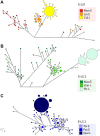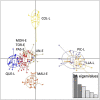Contrasting Patterns of Genetic Diversity and Divergence Between Landlocked and Migratory Populations of Fish Galaxias maculatus, Evaluated Through Mitochondrial DNA Sequencing and Nuclear DNA Microsatellites
- PMID: 35664323
- PMCID: PMC9161745
- DOI: 10.3389/fgene.2022.854362
Contrasting Patterns of Genetic Diversity and Divergence Between Landlocked and Migratory Populations of Fish Galaxias maculatus, Evaluated Through Mitochondrial DNA Sequencing and Nuclear DNA Microsatellites
Abstract
Galaxias species are interesting biogeographic models due to their distribution and different types of life cycles, with migratory and landlocked populations. To obtain a better understanding of the genetic consequences of the Quaternary glacial cycles in Galaxias maculatus, in this work we compared landlocked and migratory populations collected in areas that were differentially affected by ice advances and retreats. We included nine populations of G. maculatus, four collected from lakes (landlocked) and five from their associated estuaries/rivers (migratory) in three estuary-lake systems across southern Chile. Genetic analyses were performed using the mitochondrial control region and nine microsatellite loci. Genetic diversity measured with both markers was significantly higher in migratory than in landlocked populations across the study area. The levels of genetic differentiation showed higher differentiation among lakes than estuaries. Genetic diversity was higher in migratory populations located in areas that were less impacted by ice during Quaternary glacial processes. These results may be the consequence of recent recolonization of small freshwater bodies following the Last Glacial Maximum (LGM). Finally, the greatest differentiation was observed in populations that were exposed to continental ice advances and retreats during the LGM. Thus, in the present work we corroborate a pattern of differentiation between lakes and estuaries, using mtDNA sequences and microsatellite nuclear markers. This pattern may be due to a combination of biological factors, i.e., resident non-migratory behaviour or landlocking and natal homing-in, as well as geological factors, i.e., Expansion-Contraction Quaternary glacial biogeographic processes.
Keywords: Chile; estuary; lake; last glacial maximum; mtDNA.
Copyright © 2022 Astorga, Valenzuela, Segovia, Poulin, Vargas-Chacoff and González-Wevar.
Conflict of interest statement
The authors declare that the research was conducted in the absence of any commercial or financial relationships that could be construed as a potential conflict of interest.
Figures




References
-
- Amos W., Hoffman J. I., Frodsham A., Zhang L., Best S., Hill A. V. (2007). Automated Binning of Microsatellite Alleles: Problems and Solutions. Mol. Ecol. Notes 7 (1), 10–14. 10.1111/j.1471-8286.2006.01560.x - DOI
-
- Burridge C. P., McDowall R. M., Craw D., Wilson M. V. H., Waters J. M. (2012). Marine Dispersal as a Pre-requisite for Gondwanan Vicariance Among Elements of the Galaxiid Fish Fauna. J. Biogeogr. 39 (2), 306–321. 10.1111/j.1365-2699.2011.02600.x - DOI
LinkOut - more resources
Full Text Sources

